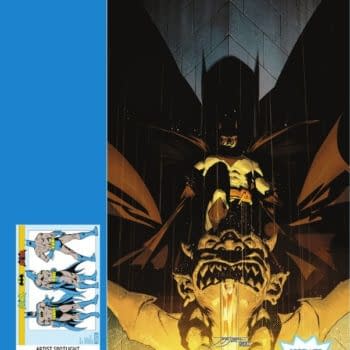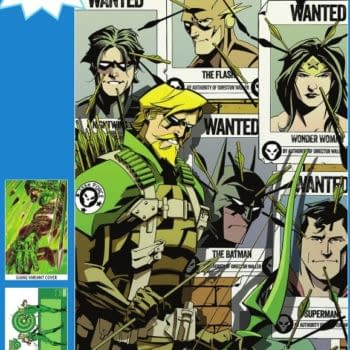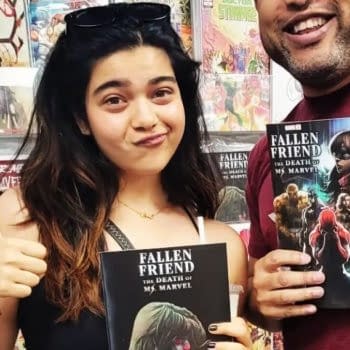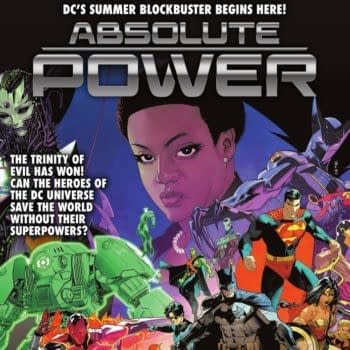Posted in: Comics, Recent Updates | Tagged: batgirl, Comics, Convergence: The Question, dc comics, Double Jumpers Vol. 1, entertainment, harley quinn, Miles Morales: Ultimate Spider-Man #11-12, Nightwing And Oracle, Speed Force, superman
Thor's Comic Review Column – Miles Morales: Ultimate Spider-Man #11-12, Double Jumpers Vol. 1, Convergence: The Question, Superman, Speed Force, Batgirl, Nightwing And Oracle, Harley Quinn
This Week's Reviews:
Miles Morales: Ultimate Spider-Man #11 & #12
Double Jumpers Vol. 1
Convergence: The Question #1
Convergence 1
Convergence: Superman #1
Convergence: Speed Force #1
Convergence: Batgirl #1
Convergence:Nightwing and Oracle #1
Convergence: Harley Quinn #1
Miles Morales: Ultimate Spider-Man #11 & #12
By Adam X. Smith
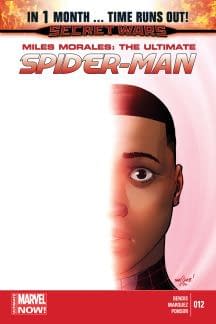
How does it fare? Meh. It gets the job done. And that is arguably its biggest flaw.
You all know the story by now.
Boy meets girl. Boy likes girl, girl likes boy. Boy and girl go steady for a while. Everything's great, except the boy has a secret – he's Spider-Man. Boy tells girl. Girl freaks out and runs away. Boy goes to girl's house to patch things up, but gets roofied by girl's agent of Hydra father. Also, there are two people robbing stuff that everyone assumes are Spider-Man imposters in spite of not looking anything like him. And then Doctor Doom shows up for reasons. Boy beats the crap out of everyone. The end… literally, the world is ending. Bigger fish, people – no time to stop and smell the daisies!
I think the important question to ask when dealing with finale books is this: what does this offer in terms of a substantial conclusion to the series? As it turns out, not an awful lot in this case. For all the build-up, there's not really a whole lot of payoff to any of the book's arcs. We have the dangling threads of Hydra and the Spider-Twins running as well as the emotional arc of Mile's girlfriend Katie's loyalties being torn, and it's revealed that Doctor Doom has teamed up with Hydra to do… something, and then the Ultimates (the kid ones, not the MIA Cap, Stark or Thor,) make a big deal of getting back together and looking for Miles…
And yet, none of those things get the air to breathe in order to hold emotional weight, or they just don't end up amounting to anything. Miles spends two issues trussed up in a cell or being tortured, and yet he still manages to take out Doctor Doom, his private Doom-bot army AND an entire Hydra cell, alone and after being tortured and experimented on, like it's nothing. He even does a weird explodey-wodey thing that looks like something out of Dragonball Z – are spider-powers like being a Super-Saiyan or something?! We don't even find out who the twins are – they could be anyone for all we know – and yet they take up so much time in the narrative that could have been spent on character development that to not even learn who they even were feels like a waste, if not of potential then at least of a little bit of Scooby-Doo level twist ending shenanigans to brighten up proceedings.
Likewise, the previous issues really had me invested in wanting to see Katie making a decision to side with Miles and redeem herself in his and our eyes – maybe work her way round to the idea of being the new Ultimate Hawkeye, I dunno – but instead, she just devolves into a child hiding behind her father and spouting doublethink, and Mile's scolding of her ceases to be righteous and lapses into spitefulness. I want to believe that Miles doesn't mean what he says to Kate, because to end it on not only such a downer but also such a bum note, one that feels so out of whack with what I've come to expect of this book, saddens me. When Tony Scott directed Quentin Tarantino's script for True Romance, he changed the downer ending not because of studio pressure but because he had been smitten with Clarence and Alabama's innocence and unconditional love, and he wanted to see these crazy kids make it in the end. I'm not asking for Miles and Katie to sail away on a magic carpet made of Tumblr reposts; I'm just saying it felt like a missed opportunity for growth.
For comparison, the nominal "finale" issue of Superior Spider-Man – a series I just never really clicked with – has an incredibly good final issue; mostly this can be chalked up by the fact that Dan Slott and co gave everything room to breathe, but a major part of it was the inclusion of Christos Gage on script duties for the A-story and writing the epilogue B-story that deals with a lot of the emotional fallout that would normally be swept aside in the name of plot development, and he gives MJ probably the best speech for a female character that I've heard from a comic book hero's "girlfriend" in a long time. Gage understands the balance between soap opera melodrama and high concept hi-jinks, and his execution on the Superior finale was superb; with all the goodwill in the world, Bendis' Ultimate Spidey wrap-up, from the man who laid the foundation stone and kept the lamps burning lo these many moons, never really rises above mediocre.
On the other hand, the abruptness of Miles and Katie's breakup does remind me of the connection between Miles Morales and Donald Glover: asides from being the original physical inspiration for the character, part of the whole Miles-Katie-betrayal melodrama reminds me of a monologue from Glover's track "That Power" about a childhood incident:-
This isn't a story about how girls are evil or how love is bad, this is a story about how I learned something and I'm not saying this thing is true or not, I'm just saying it's what I learned. I told you something. It was just for you and you told everybody. So I learned cut out the middle man, make it all for everybody, always. Everybody can't turn around and tell everybody, everybody already knows, I told them. But this means there isn't a place in my life for you or someone like you. Is it sad? Sure. But it's a sadness I chose. I wish I could say this was a story about how I got on the bus a boy and got off a man more cynical, hardened, and mature and shit. But that's not true. The truth is I got on the bus a boy. And I never got off the bus. I still haven't…
The lack of resolution at first feels like a weakness, and perhaps it was simply a by-product of the way comics are created, published and scheduled that a more satisfying ending couldn't have been achieved through giving it an extra month to wrap things up or just making the last issue giant-sized – I dunno. When your end-of-book cliffhanger is to go from rescuing Miles' loved ones, after single-handedly curb stomping Hydra and Doctor Doom, to the sudden onset of an intergalactic Armageddon, a bit of emotional whiplash is inevitable – it's the Empire Strikes Back dilemma but with the stakes and magnitude of what is involved being in complete flux.
Certainly Miles Morales isn't a stranger to world ending cataclysms – his planet almost got eaten by Galactus not so long ago – but this time it seems to be permanent; either new-new Marvel's version of Earth is going to have a major population spike or we're going to have to go through the five stages of grief for everyone that Miles Morales has ever loved – I feel like anything less than that is just going to be wrong, even if I don't want it. For a book that has always lived or died on its emotional through-line, to just delete Miles' supporting cast from existence when he enters the new world just feels like a bad move. Just my ten-cents.
And so it goes that the only ongoing Spider-Man book to hold my attention for longer than three issues straight is coming to an end, at least until after Marvel reveals what specifically is happening post-Secret Wars/Battleworld/whatever they're calling it. You know, besides the whole Avengers thing.
Adam X. Smith got married just over a week ago. There's nothing particularly funny about that, but try your best to come up with something anyway. Also, Daredevil is, to paraphrase my more descriptive housemates, is the total package.
Double Jumpers Vol. 1 TPB (Action Lab, $14.95)
By Cat Taylor
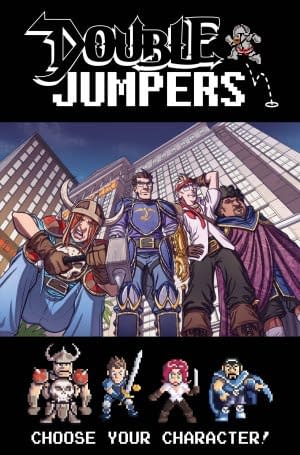
Most of the time it's only fair to give the lion's share of the credit or blame for a comic book to the writer. The artist can definitely tip the scales but if the story itself is crap, even the best artist will only be drawing amazing pictures of crap. In this case, hats off to David Dwonch for writing this tale. Initially, the idea of geeks who are transported into a fantasy video game doesn't sound all that unique. In fact, it sounds like an idea that was played out in the 1980s, but Dwonch threw in the extra twist of not only having the minds of the geeks transported into the characters of the video game but also having the personalities and artificial intelligences of the video game characters transported into the human bodies, and that's where most of the fun occurs. The story of the geeks trying to get through the fantasy adventure and crack the code to get back to reality isn't all that exciting on its own, but the fantasy characters, and their nerd-designed stereotypical fantasy personalities occupying the body space of pasty-skinned computer programmers is highly entertaining. At first they come off like the most annoying cos-play convention dorks you would never hope to meet, but when they take their "cos-play" to the next level and start fighting other attendees at a game-designers' convention, spending money like drunken sailors (this plastic card buys things? It's magic!) and having "transgender" sexual experiences (because some of the characters were gender-swapped during the mind transfer), then hellzapoppin'!
Despite recognizing the utmost importance of the writer delivering a story and script that is worthwhile, I don't mean to undermine the artist's contribution. It still wouldn't be a good comic overall if the art was terrible. Also, the artist has just as much, or sometimes greater effect, on the pacing and readability of the writer's script. In the case of Double Jumpers' artist, Bill Blankenship, he does an admirable job of making this story an easy read. He has a style that is cartoony enough to fit with the tongue-in-cheek vibe of the story, yet is detailed enough to give make the story feel identifiable. Furthermore, unlike with the work of a lot of artists, I had no trouble telling Blankenship's characters apart.
I wouldn't call Double Jumpers "laugh out loud funny" but it is a fun book that is mostly light-hearted yet doesn't shy away from sex and violence when it serves the story. Before reading this collection, I wasn't familiar with any previous work by Dwoch or Blankenship, and based on my internet research, it doesn't appear that they've done much. However, they make a great team and have produced a diamond in the rough with Double Jumpers. I've read critical acclaim for similar comics that poke fun at their own readership, such as Dork Tower, but in my opinion Double Jumpers should be rated right up there among the best.
Cat Taylor has been reading comics since the 1970s. Some of his favorite writers are Alan Moore, Neil Gaiman, Peter Bagge, and Kurt Busiek. Prior to writing about comics, Taylor performed in punk rock bands and on the outlaw professional wrestling circuit. During that time he also wrote for music and pro wrestling fanzines. Have you paid your taxes? You know that you have to file every year, don't you? You can e-mail Cat at cizattaylor@hotmail.com, but don't ask for any other tax advice.
Convergence: The Question #1 (DC Comics, $3.99)
By Devon Sanders (@devonsanders)

I'm not against it by any means. It's fine for what it is but it just wasn't made with me in mind.
One of my personal problems with the New 52 is that in fell swoop, all of the history that we'd been told to hold up to the light, no longer existed.
My memories, my joy in what I'd read, had been made into something that had to be explained away.
Wally West, The Flash of nearly three decades… gone.
Donna Troy, Wonder Woman's only sister… vanished.
Renee Montoya's The Question just… wasn't anymore.
Continuity and the idea of shared legacy and universe between characters was the thing that brought me to these characters and the invalidation of it all was what, ultimately, made me leave DC where it lay.
DC Comics knowing there's a still a contingent of comics fans who miss these characters and have questions about these characters, have given fans, Convergence, an event designed to maybe bring some closure to its prodigal sons and daughters.
In all of this DC, returns to us, one of my absolute favorite characters, Renee Montoya, The Question. MY Question. Not only does she return, she does so with her definitive creative team, writer Greg Rucka and artist Cully Hamner with Convergence: The Question #1, making this reviewer glad that even if just for a while, he can go home again.
Gotham City sits under a dome, cut off from the greater world. Anarchy and isolation have totally taken over and in an abandoned pharmacy, two familiar faces fight it out with scavengers over the last bit of morphine known to Gotham. With the flip of a coin, the scavengers fall and Harvey Dent, Two-Face becomes Gotham's most unlikely hero, giving the morphine over to Renee Montoya who'll take it to Gotham's St. Luke's Hospital to provide relief to the dead and dying. Into this uneasy alliance, comes The Huntress, preaching that desperate times bring about desperate people and none are more desperate than Harvey Dent. With the fate of Gotham at stake, Harvey Dent flips a coin and makes a choice, one that could kill a once-good man.
It's been about half a decade since Rucka and Hamner have produced any Question stories and it's like they never left. Rucka's dialogue just flows, creating a tapestry of intrigue, desperation and tension. This is a Gotham pushed even closer to the edge and in his Renee, we have a hero ready to answer its call. And that last page… (sigh)
Hamner is the rare artist who continues to improve upon his craft. Hamner, in every panel, leads the readers eye to something subtle and incredible. In scenes with Two-Face, the lines of perspective are harsh and set slightly askew, giving the reader a glimpse into Harvey's constantly distorted point-of-view. Hamner is an artist giving characters life beyond the dialogue.
Convergence: The Question #1, with its pairing of thoughtful creators and characters and remembrance of what came before, is everything I want from a DC Comic. Renee's story will again come to an end next month. I'm happy to see her again. I missed her.
Convergence: Week 1
By Graig Kent
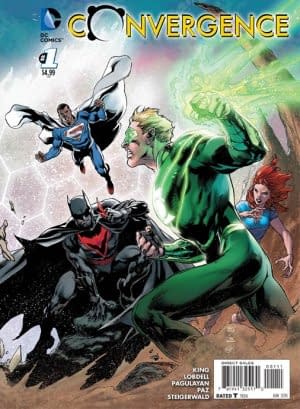
Well, there goes the good time I was expecting to have, revisiting all those characters I loved back in the 2000's, 90's and 80's. I don't want to say that the Battle Royale format is played out, because I think there's a lot of exciting stories to tell using the format (Marvel's Avengers Arena and Paul Jenkins' Deathmatch are both excellent recent comic book examples) but at the same times I had expectations that Convergence was going to be more of a celebration of DC's publishing past, rather than the dismantling and destruction of it. But we'll come back to that.
This first issue of the 8-part weekly Convergence "event" is functional, I'll give it that. Writers Jeff King and Scott Lobdell give the readers everything they needs to understand what's to come, the threat and motivation our characters face is all laid out on the page. Given that most of the foundation, outside of the "contest of champions", was handled in the zero issue, it doesn't really need to be an extra-sized, extra-glossy $5 book. There's little here that couldn't be condensed (or, for that matter, isn't presented with extreme brevity in nearly every tie-in book I read this week) and it seems that the bulk of this should properly be contained in a Convergence: Earth 2 book, instead of forcing event readers to wonder and/or care about the history of a very specific set of New 52 characters.
The art team of Carlo Pagulayan on pencils and Jason Paz on inks makes for a good looking book. They handle spandex and technology just as well as facial reactions and detailed city scapes. Their two page spreads are effectively grand, and they manage to make a story mostly set in a desert not look altogether boring. It's some solid superhero storytelling but there's no standout wow-factor that one comes to expect from event books.
Stepping out of the main weekly and into Convergence's reason for being, I looked at six of this week's offerings, which may be the largest pick up I will have of the event's four-week cycle. Week 1 focuses on the "heroes of pre-Flashpoint DCU", in other words, the heroes we had to give up to get "The New 52". For me, these were the heroes I grew up with, I spent more than 20 years with, watching them grow and evolve, die and carry on, crisis-after-crisis. These were the heroes I most looked forward to seeing when Convergence was announced, as many were on new journeys that got cut short. Renee Montoya as the Question, Wally West and his kids, Stephanie Brown donning the Batgirl mantle under Oracle's guidance… there was still so much more to explore that I was excited that we were getting that chance.
What I didn't understand about Convergence until now, was that what it represents is the true end to these characters, placed in a situation from which they're not going to survive. There's a true darkness underpinning this event, a nihilism creeping out from every pore. Imagine if you were watching the next Hunger Games movie and Katniss Everdeen emerged from the Tribute tube into the arena only to see that every other person she has to fight there is your favourite character from another series. There's Chewbacca, and over there is Finn from Adventure Time, and poor Hurley from Lost, and Samurai Jack (he's just never going to get back home). Felicity from Arrow, Gizmo, Don Draper (watch out Felicity!), Django, and WALL-E… you get the picture. You can't feel good about seeing any of these characters being there, despite being happy to see them. Katniss here represents the New 52, in that you know since it's her show, she's going to win, so ultimately, you're seeing these other characters again only to watch them for the last time.
—
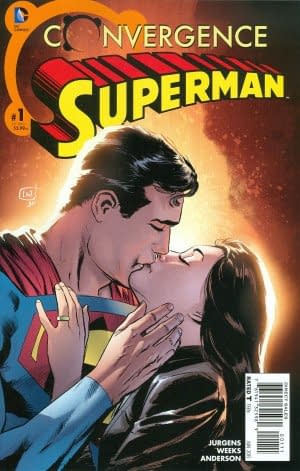
Excusing the fact that Jurgens has to find an excuse to put Lois, Clark, Jimmy and Professor Hamilton in Gotham at the time of the city's abduction (a problem every book save the Bat-themed ones face this week) this does feel like a vintage Superman tale. And that's actually the problem. Five years ago, the assumption would be that Superman (and pretty much everyone else) will figure out some way to stop the bulk of this bloodbath, and rescue most of the cities, returning them to their homes. This Superman has done that hundreds of times, it's a no brainer that he will get it done. Yet, the foregone conclusion here is this is no longer DC's Superman, and that he, and Lois, and their baby, are going to meet an end, rather than a new beginning, and that bums me the hell out.
Weeks is reunited again with Jurgens from Futures End: Superman [link: https://bleedingcool.com/2014/09/29/thors-comic-review-column-superman-doomed-g-i-joe-butterfly-futures-end-month-week-4-a-voice-in-the-dark-volume-1-and-get-your-gun/], and as good as he was on that book, he's even better here. I was unsure how suited his darker line style was for Superman with that book, but I've changed my mind here: he's a perfect fit. Perhaps it's even more appropriate for the dark currents running underneath, but Anderson's coloring makes the costumes pop amid the many shadows. The shot of Superman decking Captain Thunder is gorgeous. Why Weeks isn't working on a top selling title right now (Justice League, Avengers, Spider-something) is beyond me. The man is a gift to comics, undervalued for too long.
—
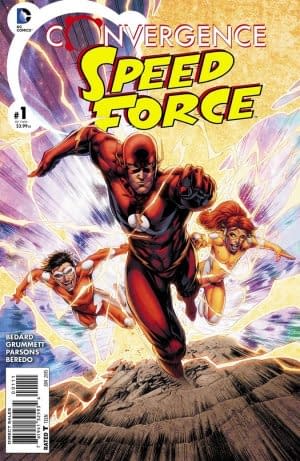
The first three pages are a flashback (no pun intended) which show Wally dragging the kids along with him to Gotham City just before its abduction (and here it's noted a number of heroes were called here in response to a "JLA Alert"), immediately cutting to current day where a powerless Wally smacks at the dome futiley, looking haggard. For the better part of the year he's been trying so hard to find his way back to his wife, Linda, that he's been largely ignoring the kids, and when the dome finally lets up, and his powers return he races out to go help, failing to realize the full scope of his situation (the fact that Telos announces that his "world is dead", meaning that Linda is gone too, he surprisingly doesn't react to). The book, for the most part, is depressing as hell. Not only does it paint Wally in a bad light as a father, as well as unceremoniously killing off Linda, but also Wally just appears heavy and burdened the entire time. Grummet illustrates this in Wally, and I'm not certain if Bedard meant the script to be this dark. It ends with Wally and the kids in Follywood, Califurnia, face to face with Fastback from Captain Carrot's Amazing Zoo Crew (Grummet's art is perfect for having human and cartoon animal worlds work in sync). Normally, this would be ridiculously fun meeting, but all the joy seems sucked out of such an adventure, particularly when the grim Flashpoint Wonder Woman and her Amazons are threatening to annihilate them all. It's actually quite distressing
—
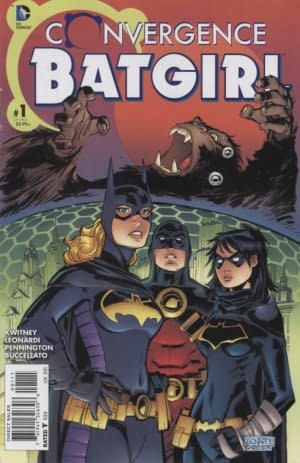
To writer Alisa Kwitney's credit, she captures Steph's voice perfectly. Steph's decision to stop fighting and find other ways to make the situation better, particularly her view on what that all means, is key to what made (makes?) Stephanie such a distinct and standout character. Called back to the fray by Telos, chosen as one of the combatants to represent her Gotham, she's anxious, worried, unprepared, but willing to do it anyway. Tim Drake and Cassandra Cain are by her side, but she knows this is her fight, not theirs, and that she will resolve this her way, not Telos' or anyone elses. The story jumps throughout the timeline of Stephanie's time under the dome and presents a good picture of what happened to Gotham during that time. Kwitney does a fine job drafting a smile-while-your-heart-is-breaking kind of story, injecting Steph's levity in the narration while obviously carrying the weight of everything going on. On top of the dissatisfying situation in which Steph is forced to partake, the art from Rick Leonardi and Mark Pennington is disappointing. Leonardi's style has loosened up dramatically to the point that it looks sloppy, like breakdowns or a rough draft, not a polished final product.
—
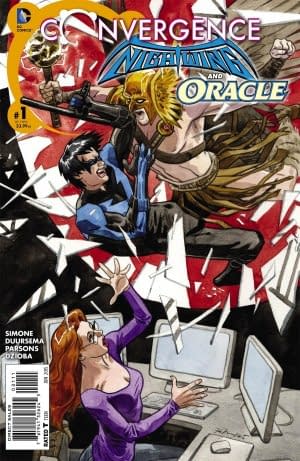
The art team of Jan Duursema and Dan Parsons (with Wes Dzioba's colours) ably highlight the darkness that Gotham has fallen under, and unveils the glimmer of light that results when the dome is lifted. Unlike the other titles, where the heroes feel their powers surge back, here the impact of the dome's disappearance is all subtle visually. Flashpoint's Hawkman and Hawkwoman — nasty, horrible, tyrannical aliens who just destroyed the old west Justice Riders town (as also seen in Convergence Speed Force)– come to Gotham to face Nightwing, but with a proposition, and not the first Barbara's faced that evening. Of all the books, this one has the most exciting cliffhanger.
—
Speaking of owning characters, Renee Montoya as the Question wouldn't exist without Greg Rucka (and she actually doesn't) so it's fantastic to see not only a Convergence: The Question title, but also one written by Rucka (partnered again with Cully Hamner on the character). Devon has already written more at length about it, and I couldn't agree more with his every sentiment.
—
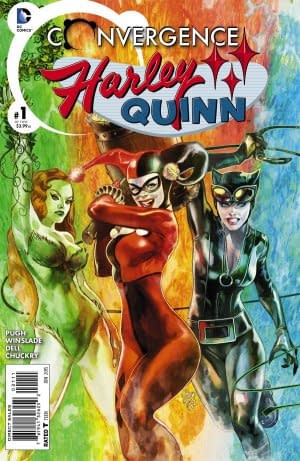
Before even reading the book, I was disappointed. I have a tendency to flip through a book before I read it (for better or worse), and there's only one measly panel of Captain Carrot here. I didn't like it at all. Had I been buying the books this week (my wife picked them up) I would have left it on the stand.
I'm glad that didn't happen, though.
Of all the Convergence books, it's this one that most met my expectation for what this event would be. It's Harley Quinn who made this a sentimental, fun and enjoyable journey in spite of the heaviness lurking underneath. It turns out Pugh is as fine a writer as he is an artist, and his story here takes crazy ol' Harley on a tremendous journey to sanity and back. Instead of darkness underpinning the book, it's a love story between Harley and a police officer whom she almost killed. Catwoman and Poison Ivy co-star (as former teammates, I guess this more than makes sense) as the ones who need to ruin Harley's blissful new life in order to get her into enough shape to beat a cartoon rabbit. It's not something they relish doing. Pugh's script is loaded with sentimentality, but he manages to avoid making it saccharine at every turn. Instead, Harley's manic energy, is crackling around the edges at all times, getting ready to explode.
Winslade (with inks by John Dell) does a better job with bubbly, poppy Harley than I had originally anticipated, but his pseudo-realistic style, rife with detail still doesn't fit the character very well. It's especially noticeable when he has to draw Captain Carrot… what a sad looking image that is. Some artists just can't escape from their own style and Winslade's Carrot is way too defined, way too muscular, and not at all cartoony. Even the Flash's kids note (back in the Convergence: Speed Force #1) they're "like a living cartoon". Harley should be the Bob Hoskins (or maybe Christopher Lloyd) to Captain Carrot's Roger Rabbit.
As a massive event, Convergence isn't so much a winner as it is a downer. It's not nearly as enjoyable or as fun as I was hoping. As well written as the tie-in books are, with obvious investment in the characters from the writers, the conceit these books must bow to seems to be appealing more to the New 52 fans than DC fans of old. But if this is supposed to be a celebration of DC's publishing past, it's like having a birthday in prison…it's not a real party. To be honest, it bummed me out more than watching two end of the world movies back-to-back (Melancholia and These Final Hours) last week.
Beyond the saddening conceit of it though, there's obvious little problems, such as the disjointed portrayal of Gotham City and some of the portrayals of characters between the different books (I can only imagine there's more continuity issues in the other books I didn't read) that lay in the laps of editorial oversight. I guess they were too busy packing? As well a lot of the characters and situations feel more than forced into place than naturally fitting (Superman in Gotham, seriously).
Next week's run of titles center around "the heroes of Zero Hour". This isn't one of my favourite eras of DC comics, so expect a lighter pack of reviews.
Graig Kent used to be a huge, huge, huge fan of DC Comics. Unhealthily so. He kind of hopes he will be again one day.










